Dynamics of Muddy Rain of 15 June 2018 in Nepal
Abstract
1. Introduction
2. Methodology
3. Results and Discussion
3.1. Observation of Dust Storms from Some Surface Stations
3.2. Dust Storms and the Dust Advection
3.3. Synoptic Overview from the MERRA
3.4. Evolution of the Dust by an Aerosol Modeling of Navy Aerosol Analysis and Prediction System (NAAPS) and Dust Scattering AOT by MERRA-2
3.5. Rawinsonde Soundings Analyses
3.6. Analyses of Backward Trajectory and Vertical Reach of Dust
4. Conclusions
Author Contributions
Funding
Acknowledgments
Conflicts of Interest
References
- Seinfeld, J.; Carmichael, G.; Arimoto, R.; Conant, W.; Brechtel, F.; Bates, T.; Cahill, T.; Clarke, A.; Doherty, S.; Flatau, P.; et al. ACE-ASIA: Regional climatic and atmospheric chemical effects of Asian dust and pollution. Bull. Am. Meteor. Soc. 2004, 85, 367–380. [Google Scholar] [CrossRef]
- Tegen, I. Modeling the mineral dust aerosol cycle in the climate system. Quat. Sci. Rev. 2003, 22, 1821–1834. [Google Scholar] [CrossRef]
- Appel, B.; Tokiwa, Y.; Hsu, J.; Kothny, E.; Hahn, E. Visibility as related to atmospheric aerosol constituents. Atmos. Environ. 1985, 19, 1525–1534. [Google Scholar] [CrossRef]
- Chan, Y.; Simpson, R.; Mctainsh, G.; Vowles, P.; Cohen, D.; Bailey, G. Sourceapportionment of visibility degradation problems in Brisbane (Australia)—Using the multiple linear regression techniques. Atmos. Environ. 1999, 33, 3237–3250. [Google Scholar] [CrossRef]
- Okin, G.S.; Reheis, M.C. An ENSO predictor of dust emission in the southwestern United States. Geophys. Res. Lett. 2002, 29. [Google Scholar] [CrossRef]
- Reheis, M.; Kihl, R. Dust deposition in southern Nevada and California, 1984 1989: Relations to climate, source area, and source lithology. J. Geophys. Res. 1995, 100, 8893–8918. [Google Scholar] [CrossRef]
- Pokharel, A.; Kaplan, M. Dust Climatology of the NASA Dryden Flight Research Center (DFRC) in Lancaster, California, USA. Climate 2017, 5, 15. [Google Scholar] [CrossRef]
- Okin, G.S.; Gillette, D.A.; Herrick, J.E. Multi scale controls on and consequences of Aeolian process in landscape change in arid and semi-arid environments. J. Arid Environ. 2006, 65, 253–275. [Google Scholar] [CrossRef]
- Pokharel, A.; Kaplan, M.; Fiedler, S. Subtropical Dust Storms and Downslope Wind Events. J. Geophys. Res. Atmos. 2017, 122, 10. [Google Scholar] [CrossRef]
- Pokharel, A.; Kaplan, M. Organization of dust storms and synoptic scale transport of dust by Kelvin waves. Earth Syst. Dynam. 2019, 10, 651–666. [Google Scholar] [CrossRef]
- Pokharel, A.; Kaplan, M.; Fiedler, S. The Role of Jet Adjustment Processes in Subtropical Dust Storms. J. Geophys. Res. Atmos. 2017, 122, 12. [Google Scholar] [CrossRef]
- Pokharel, A.; Kaplan, M.; Fiedler, S. Atmospheric Dynamics of the Harmattan Surge on March 2, 2004. In Proceedings of the 2nd International Conference on Atmospheric Dust–DUST 2016, Taranto, Italy, 12–17 June 2016; pp. 85–93. [Google Scholar] [CrossRef]
- Pokharel, A. Atmospheric Dynamics of Sub-Tropical Dust Storms. Ph.D. Thesis, University of Nevada, Reno, USA, 2016. Available online: https://ui.adsabs.harvard.edu/abs/2016PhDT98P/abstract (accessed on 3 February 2020).
- Brazel, A.; HSU, S. The climatology of hazardous Arizona dust storms. Desert Dust 1981, 186, 293–303. [Google Scholar] [CrossRef]
- SciJinks. Available online: https://scijinks.gov/dust-storm/ (accessed on 3 February 2020).
- Goudie, A.; Middleton, N. Dust storms in South West Asia. Acta Universitatis Carilinae Suppl. 2000, 73–83. [Google Scholar]
- Jauregui, E. The dust storms of Mexico City. Int. J. Climatol. 1989, 9, 169–180. [Google Scholar] [CrossRef]
- Baral, K.N.; Mackerras, D. The cloud flash-to-ground flash ratio and other lightning occurrence characteristics in Kathmandu thunderstorms. J. Geophys. Res. 1992, 97, 931–938. [Google Scholar] [CrossRef]
- Zifa, W.; Hiromasa, U. Modelling of Long Range Transport of Yellow Sand and Muddy Rain in East Asia; Annuals of Disasters Prevention Research Institute, Kyoto University: Kyoto, Japan, 1999; No. 42 B-1. [Google Scholar]
- Hedin, L.; Likens, G. Atmospheric Dust and Acid Rain. Sci. Am. 1996, 275, 88–92. [Google Scholar] [CrossRef]
- Loÿe-Pilot, M.D.; Martin, J.M.; Morelli, J. Influence of Saharan dust on the rain acidity and atmospheric input to the Mediterranean. Nature 1986, 321, 427–428. [Google Scholar] [CrossRef]
- The Himalayan. Available online: http://thehimalayantimes.com/nepal/kathmandu-valley-receives-muddy-rain/ (accessed on 3 February 2020).
- Twitter. Available online: https://twitter.com/rupajoshi/status/1007806022805700608/photo/1 (accessed on 3 February 2020).
- Weather Underground. Available online: Weatherunderground.com (accessed on 3 February 2020).
- Stolbova, V.; Martin, P.; Bookhagen, B.; Marwan, N.; Kurths, J. Topology and seasonal evolution of the network of extreme precipitation over the Indian subcontinent and Sri Lanka. Nonlin. Processes Geophys. 2014, 21, 901–917. [Google Scholar] [CrossRef]
- MODIS/Terra. Available online: https://worldview.earthdata.nasa.gov (accessed on 3 February 2020).
- MERRA. Available online: https://disc.sci.gsfc.nasa.gov/mdisc/data-holdings/merra/merra_products_nonjs.shtml (accessed on 3 February 2020).
- NAAPS. Available online: https://www.nrlmry.navy.mil/aerosol_web/ (accessed on 3 February 2020).
- MERRA-2/Giovanni. Available online: https://giovanni.gsfc.nasa.gov/giovanni/ (accessed on 3 February 2020).
- University of Wyoming sounding. Available online: http://weather.uwyo.edu/upperair/sounding.html (accessed on 3 February 2020).
- HYSPLIT. Available online: https://www.ready.noaa.gov/HYSPLIT.php (accessed on 5 March 2020).
- CALIPSO. Available online: https://www-calipso.larc.nasa.gov/tools/data_avail/index.php?d=2018 (accessed on 5 March 2020).
- Stull, R. Meteorology for Scientists and Engineers, 2nd ed.; Brooks Cole: Pacific Grove, CA, USA, 1999. [Google Scholar]
- Sarkar, S.; Chauhan, A.; Kumar, R.; Singh, R.P. Impact of deadly dust storms (May 2018) on air quality, meteorological, and atmospheric parameters over the northern parts of India. GeoHealth 2019, 3, 67–80. [Google Scholar] [CrossRef] [PubMed]
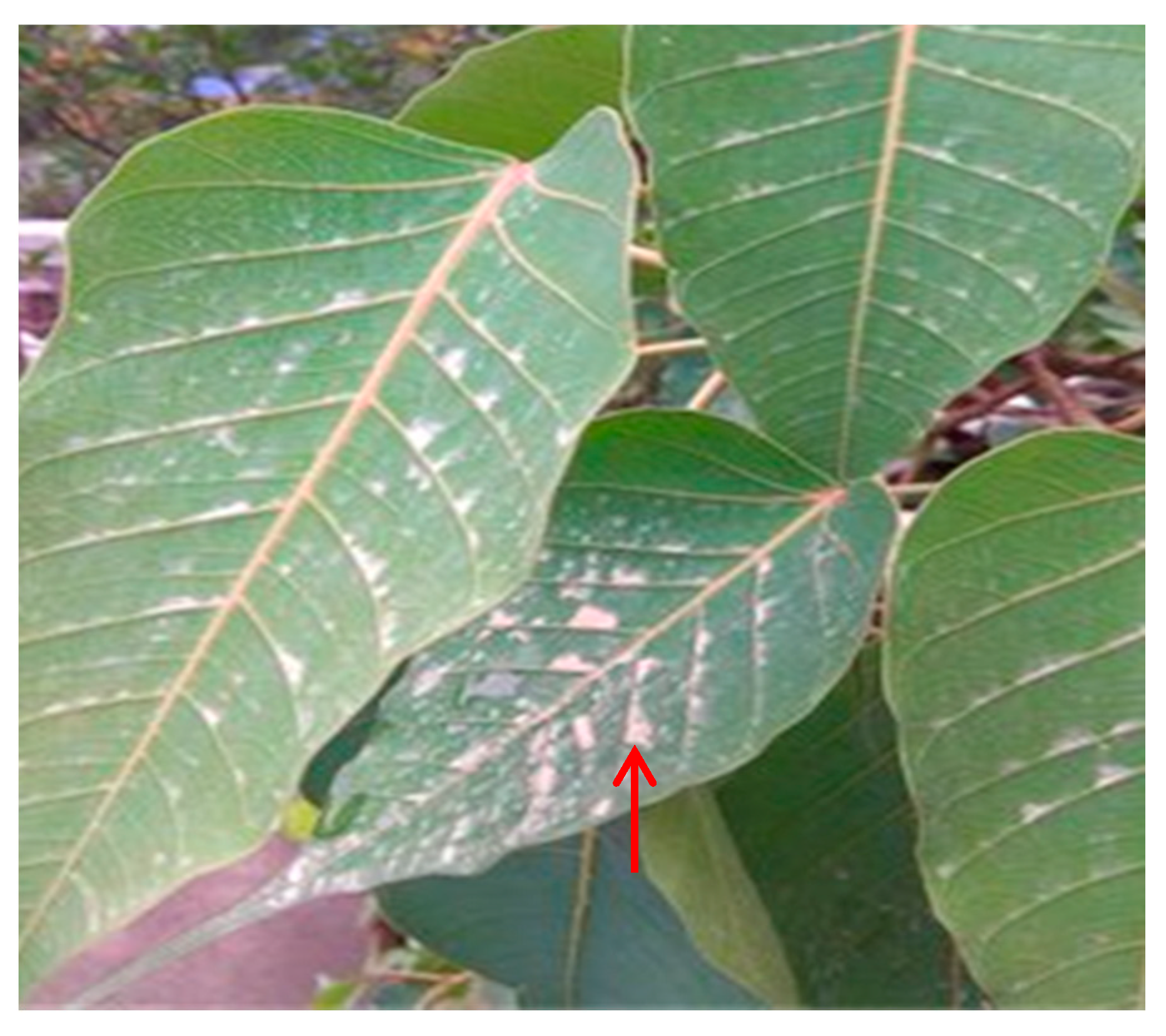
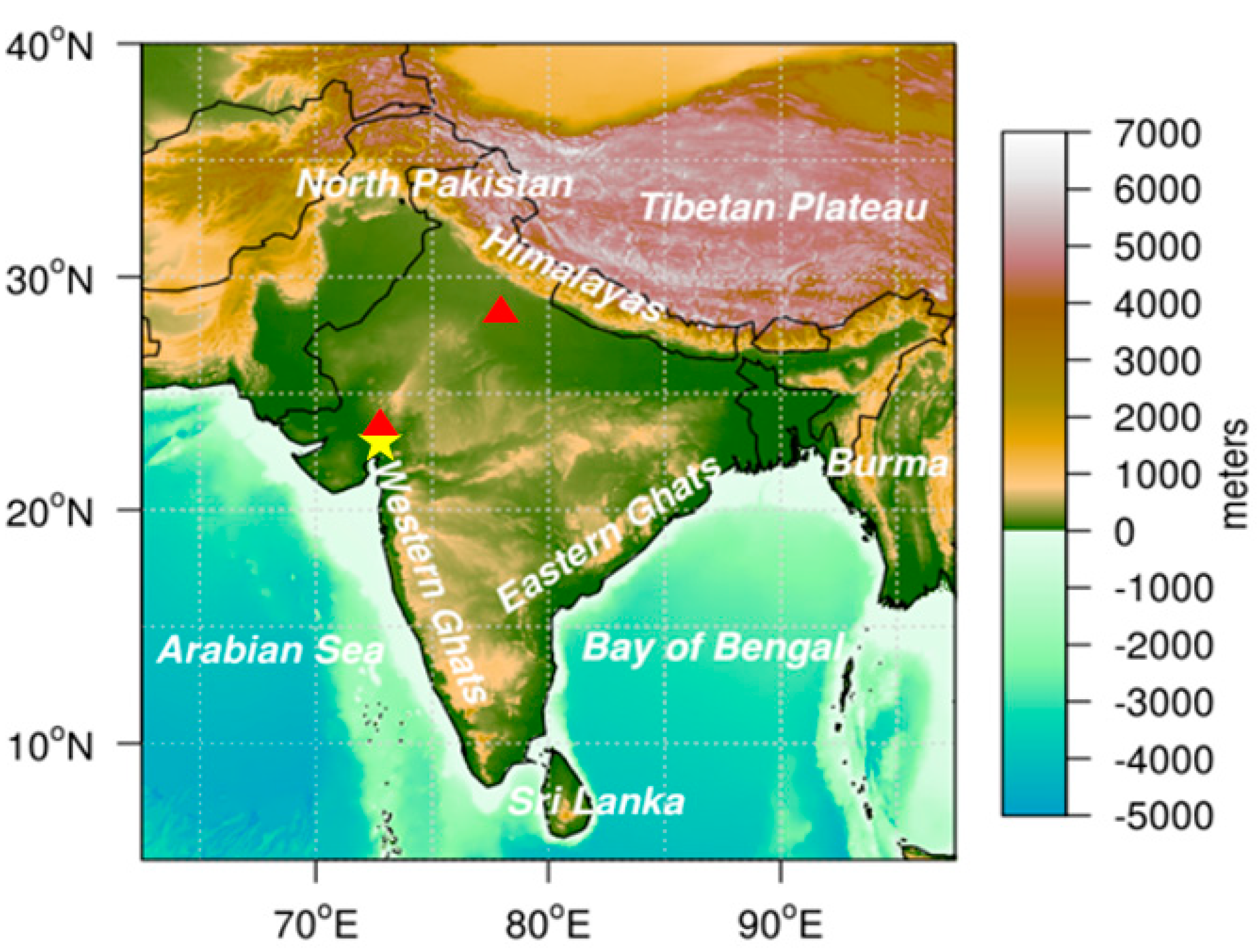
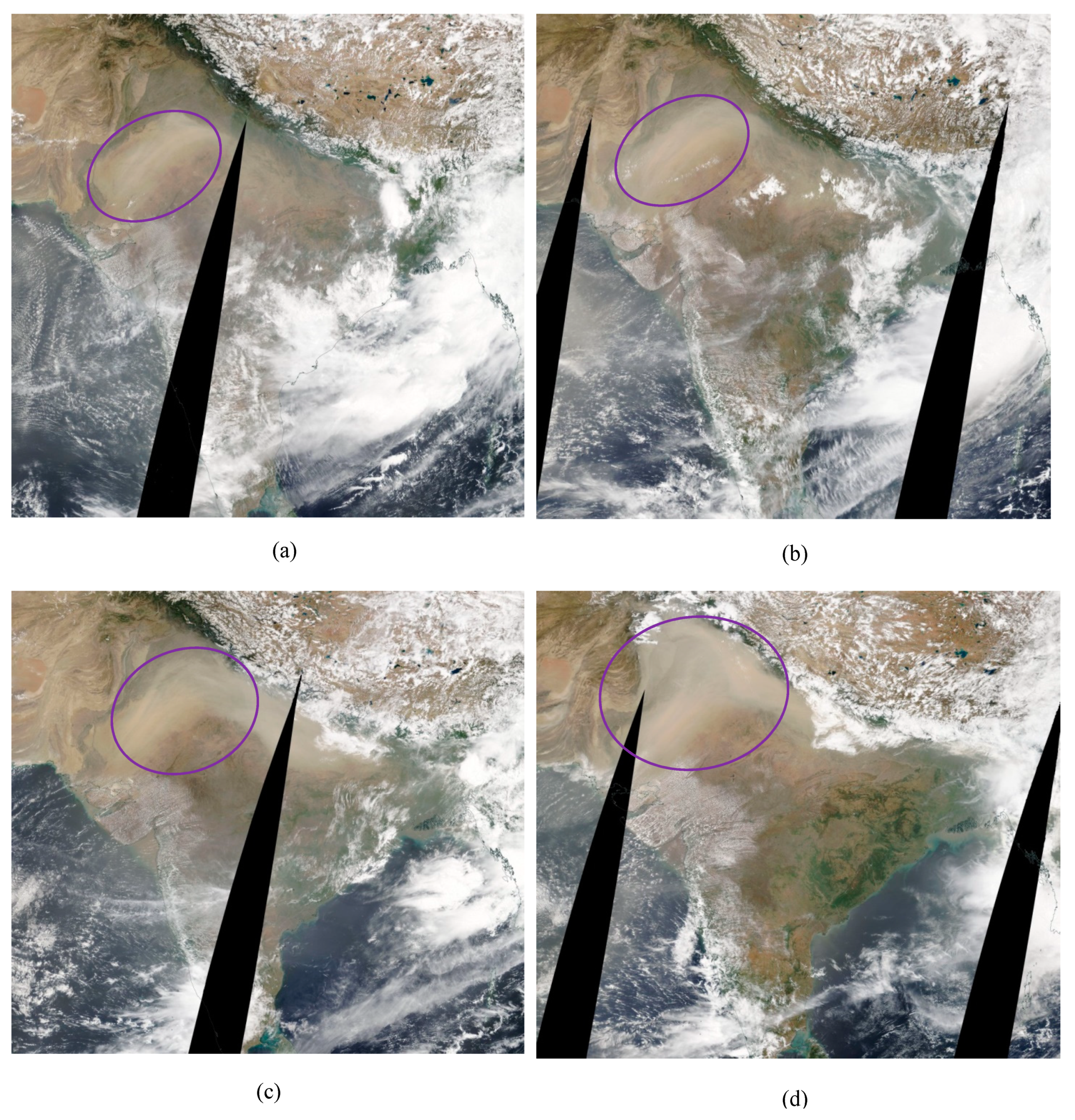

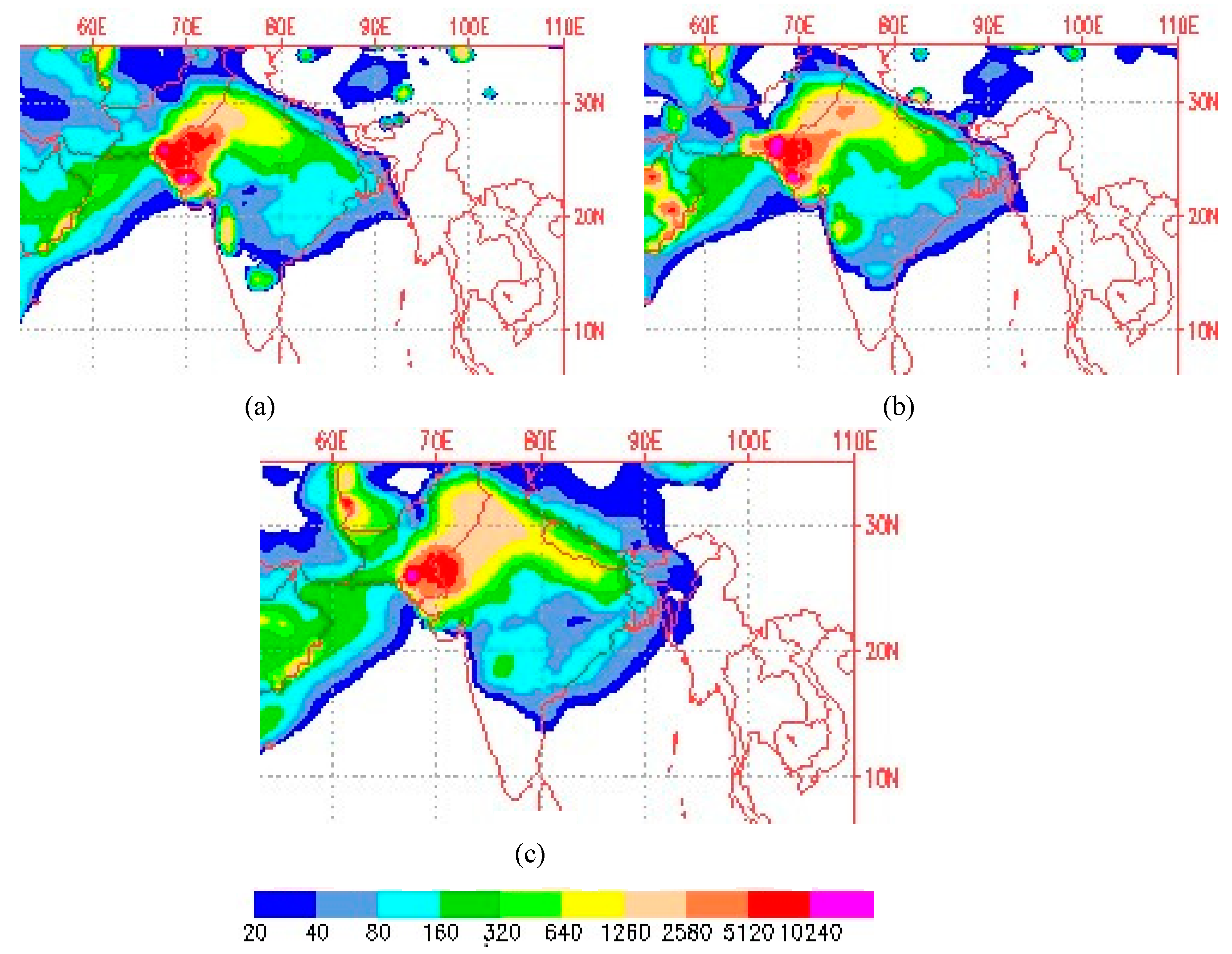
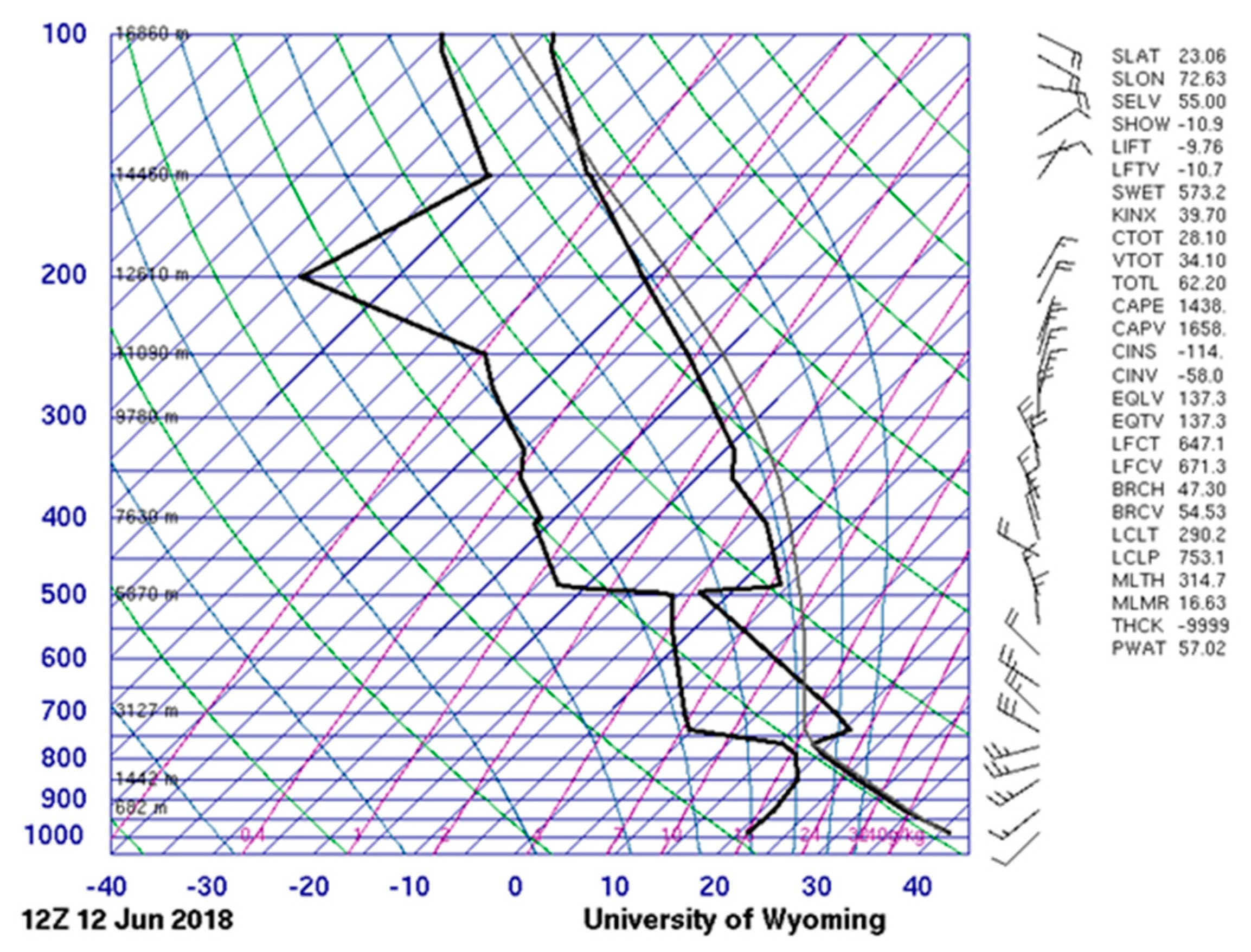
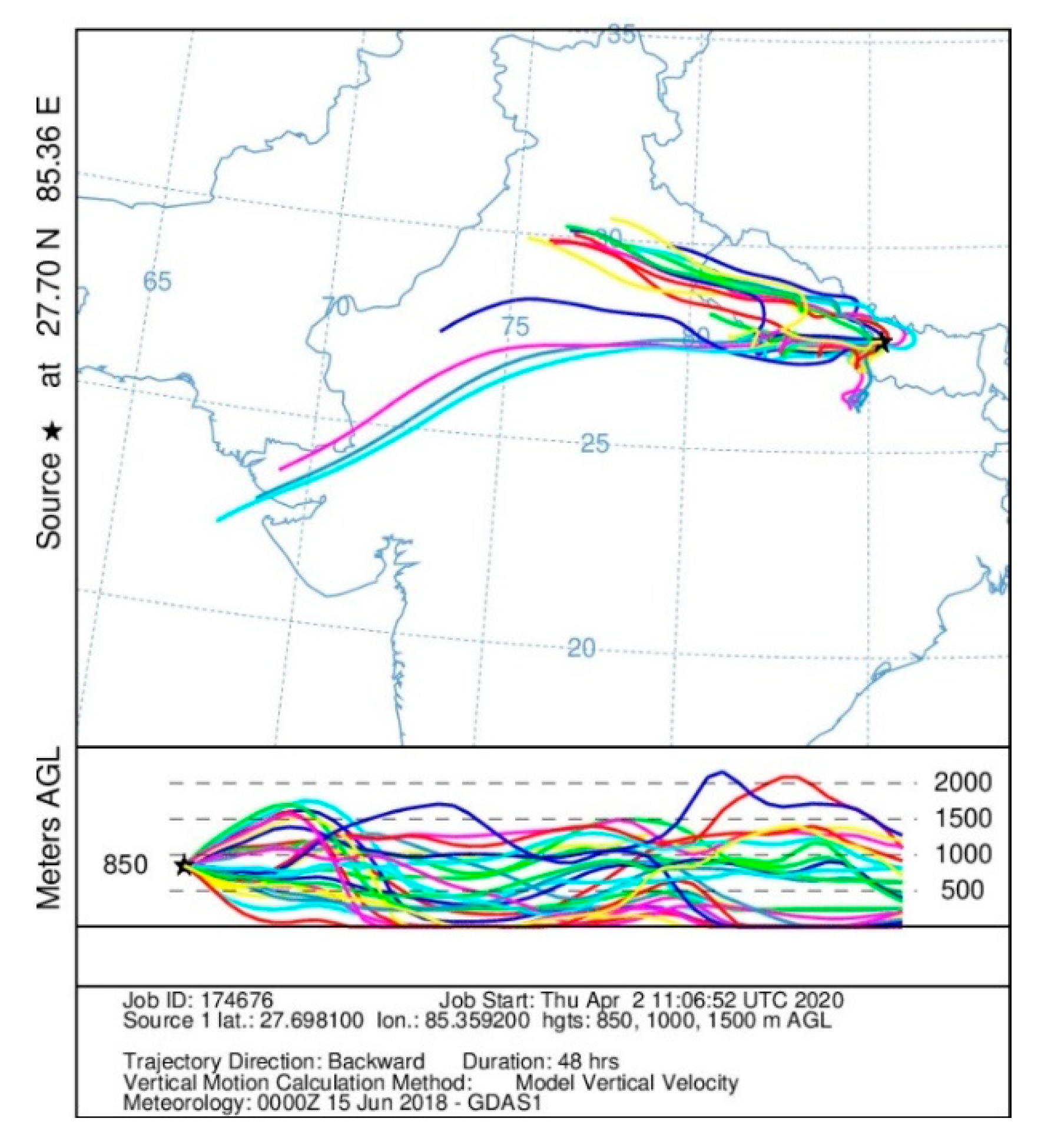
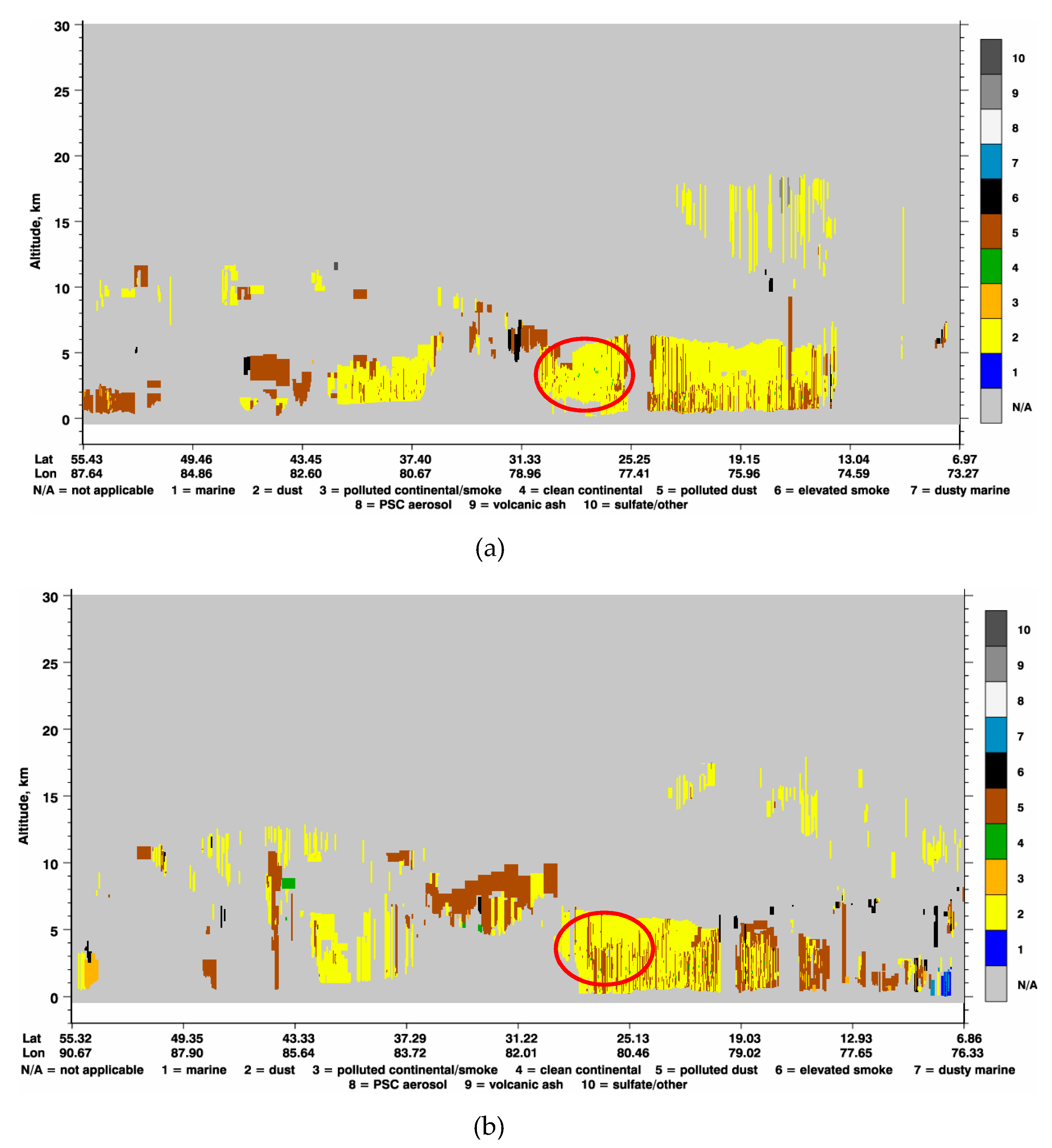

| Name of Surface Stations | Date of Dust Storms | Local Time | Wind Speed (m s−1) | Wind Direction |
|---|---|---|---|---|
| Safdarjung Airport, India | 12 June 2018 | 5:45 a.m. to 8:45 a.m. | 6.26 to 8.05 | Westerly/West-northwesterly |
| 13 June 2018 | 5:45 a.m. to 11:45 a.m. | 7.60 to 9.39 | Westerly | |
| 14 June 2018 | 3:45 a.m. to 8:45 a.m. | 4.47 to 7.15 | West-southwesterly | |
| 15 June 2018 | 3:45 a.m. 5:45 a.m. | 6.26 to 7.60 | West/west-southwesterly | |
| Sardar Vallabhbhai Patel International Airport, India | 12 June 2018 | 6:45 a.m. to 11:45 a.m. | 4.02 to 5.36 | Westerly/Southwesterly/West-southwesterly |
| 13 June 2018 | 4:15 a.m. to 11:15 p.m. | 2.68 to 6.26 | Westerly/Southwesterly/West-southwesterly | |
| 14 June 2018 | 12:45 a.m. to 11:15 p.m. | 2.68 to 7.15 | South-southwesterly/West-southwesterly | |
| 15 June 2018 | 5:45 a.m. to 5:45 p.m. | 2.68 to 7.70 | Southwesterly/South-southwesterly/West-southwesterly |
© 2020 by the authors. Licensee MDPI, Basel, Switzerland. This article is an open access article distributed under the terms and conditions of the Creative Commons Attribution (CC BY) license (http://creativecommons.org/licenses/by/4.0/).
Share and Cite
Pokharel, A.K.; Xu, T.; Liu, X.; Dawadi, B. Dynamics of Muddy Rain of 15 June 2018 in Nepal. Atmosphere 2020, 11, 529. https://doi.org/10.3390/atmos11050529
Pokharel AK, Xu T, Liu X, Dawadi B. Dynamics of Muddy Rain of 15 June 2018 in Nepal. Atmosphere. 2020; 11(5):529. https://doi.org/10.3390/atmos11050529
Chicago/Turabian StylePokharel, Ashok Kumar, Tianli Xu, Xiaobo Liu, and Binod Dawadi. 2020. "Dynamics of Muddy Rain of 15 June 2018 in Nepal" Atmosphere 11, no. 5: 529. https://doi.org/10.3390/atmos11050529
APA StylePokharel, A. K., Xu, T., Liu, X., & Dawadi, B. (2020). Dynamics of Muddy Rain of 15 June 2018 in Nepal. Atmosphere, 11(5), 529. https://doi.org/10.3390/atmos11050529





